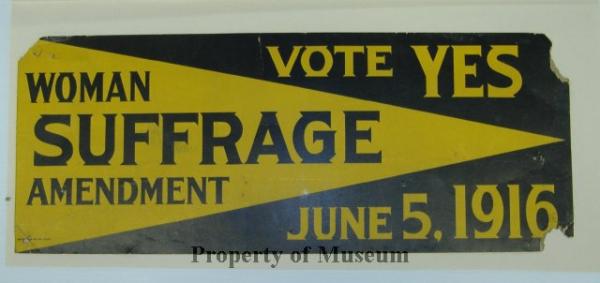All Voices Matter: Women's Suffrage
| Grade | 8th Grade | Class | U.S. History | Length of Lesson |
| Lesson Title | All Voices Matter: Women's Suffrage |
| Unit Title | |
| Unit Compelling Question | |
| Historical Context: Carrie Chapman Catt was born in Wisconsin, but grew up in Charles City, Floyd County, Iowa. After high school, she attended Iowa State Agricultural College (now Iowa State University), in Ames, Iowa. She worked several jobs while in college, and became a leader in gaining women the right to speak during meetings and debates. She graduated in 1880 and became a teacher and then the first female superintendent of schools in Mason City, Iowa. She campaigned for women's rights with the Iowa Woman Suffrage Association and the National American Woman Suffrage Association, eventually serving as president. Her second term was 1915-1920, the time period of this banner. Victoria Woodhull was an advocate for womens' rights who fought for the right to vote, as well as the idea of free love where it is the woman's decision as much as a man's to marry, divorce or have children. Woodhull had many firsts for women: the first woman to run for President (this can be considered unofficial however since she was under 35), first woman to publish a newspaper and first to operate a brokerage wall firm on Wall Street. ### In 1870, a bill that would have removed the word "male" from Iowa's voting qualifications passed the Iowa legislature; however, a controversial speech given by a British women's suffrage supporter named Victoria Woodhull derailed women's suffrage in Iowa and other states. On June 5, 1916, Iowa men voted on another effort to grant voting rights to Iowa women. This sign encouraged men to vote yes on the referendum. The 1916 referendum was voted down, and women did not receive the right to vote at that time. Women finally received the right to vote when Iowa became the 10th state to ratify the 19th Amendment was ratified on July 2, 1919. This sign is from the collection of the State Historical Society of Iowa. ### In 2020, the United States will celebrate 100 years since women were insured the right to vote as citizens. When the United States became a new nation, not everyone had the right to vote. For the most part, only white men who owned property participated in elections. Native Americans, blacks, and men who didn't own land were not considered part of the political process. Women were expected to take care of the home and family. Men's role was to represent the family in public affairs. In 1848, a women's convention in Seneca Falls, NY, called for expanding the legal rights of women, including the right to vote. The issue gained more attention at the end of the Civil War when black men were allowed the right to vote but women, black or white, were not. Women's suffrage organizations formed to try to persuade legislators to change the law. In 1969, Wyoming became the first state to grant women the vote. There were some close votes in the Iowa legislature in favor of women's suffrage, but the cause was never completely successful. The law was changed to allow women to vote in bond issues and referenda where there were no candidates on the ballot but not in elections. In 1916, the legislature submitted a women's suffrage referendum to Iowa voters (all male), but it was narrowly defeated. Congress passed an amendment in 1919 mandating voting rights for women if it was approved by three fourths (36 of 48) of the states. Iowa was the 10th state to approve it. In August, 1920, Tennessee added the final tally, and women were allowed to vote in the Presidential election of that year. Women's suffrage was rarely considered on its own merits. For some, it represented too great a shift in the traditional gender roles. Were women qualified to participate in politics? Would it undercut men's authority in the home? The Bible states that the man is the head of the family and the wife should be subordinate. Debates on restriction of the sale of alcohol were a heated topic, resulting in the 19th Amendment to the U.S. Constitution in 1919 that prohibited its sale across the country. Opponents of prohibition were usually opponents of granting women the right to vote in fear that they would support stricter controls. Because of their support for schools and libraries, women were accused of favoring higher taxes which many opposed. On the other hand, women's suffrage groups argued that women had a right to vote in a country that boasted of equality-that all are created equal. They also pointed out the women had served faithfully in wartime and played an important part in community affairs. Women needed the vote, they argued, to insure clean and healthy communities for the welfare of their homes and children. As women's roles expanded, so did support for the full participation of women at the ballot box, but it took 75 years from the Seneca Falls convention to passage of the 19th Amendment. |
|
| Lesson Supporting Question | |
| Lesson Overview | In 1870, a bill that would have removed the word "male" from Iowa's voting qualifications passed the Iowa legislature; however, a controversial speech given by a British women's suffrage supporter named Victoria Woodhull derailed women's suffrage in Iowa and other states. On June 5, 1916, Iowa men voted on another effort to grant voting rights to Iowa women. This sign encouraged men to vote yes on the referendum. The 1916 referendum was voted down, and women did not receive the right to vote at that time. Women finally received the right to vote when Iowa became the 10th state to ratify the 19th Amendment was ratified on July 2, 1919. Women weren’t always allowed to vote. In this lesson we will look at the process of specifically women’s suffrage. We will see some key figures in the movement, and we will look at an artifact from the time period. |
| Primary Sources Used |
|
| Resources Needed | http://teacher.scholastic.com/activities/suffrage/quiz/index.asp |
| Standard | |
| Lesson Target | |
| Lesson Themes | Lawmaking, Women's Experience |
|
| Formative Assessment (How will you use the formative assessments to monitor and inform instruction?) |
H.I.P.P.O.S using the sign artifact. (worksheet attached) |
| Summative Assessment (How does the lesson connect to planned summative assessment(s)?) |
Quiz; One minute paper - tweet style. 125 characters. |
| Author | Connor McKibben | Created | Last Edited | ||||
| Reviewer: Dr. Lisa Millsaps, University of Northern Iowa | |||||||
| Lesson Plan Development Notes: Teaching Methods, University of Northern Iowa, Fall 2018 | |||||||


